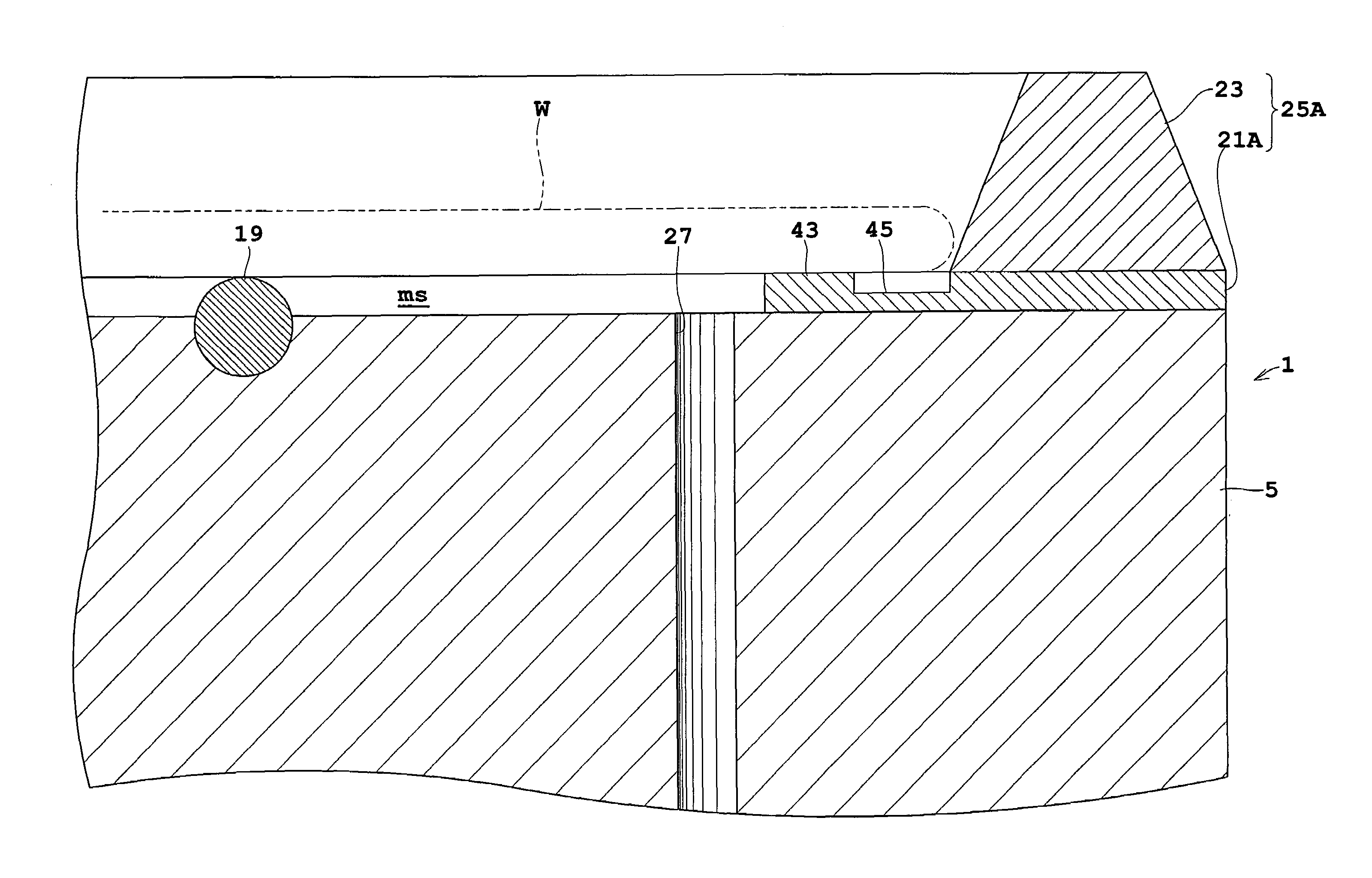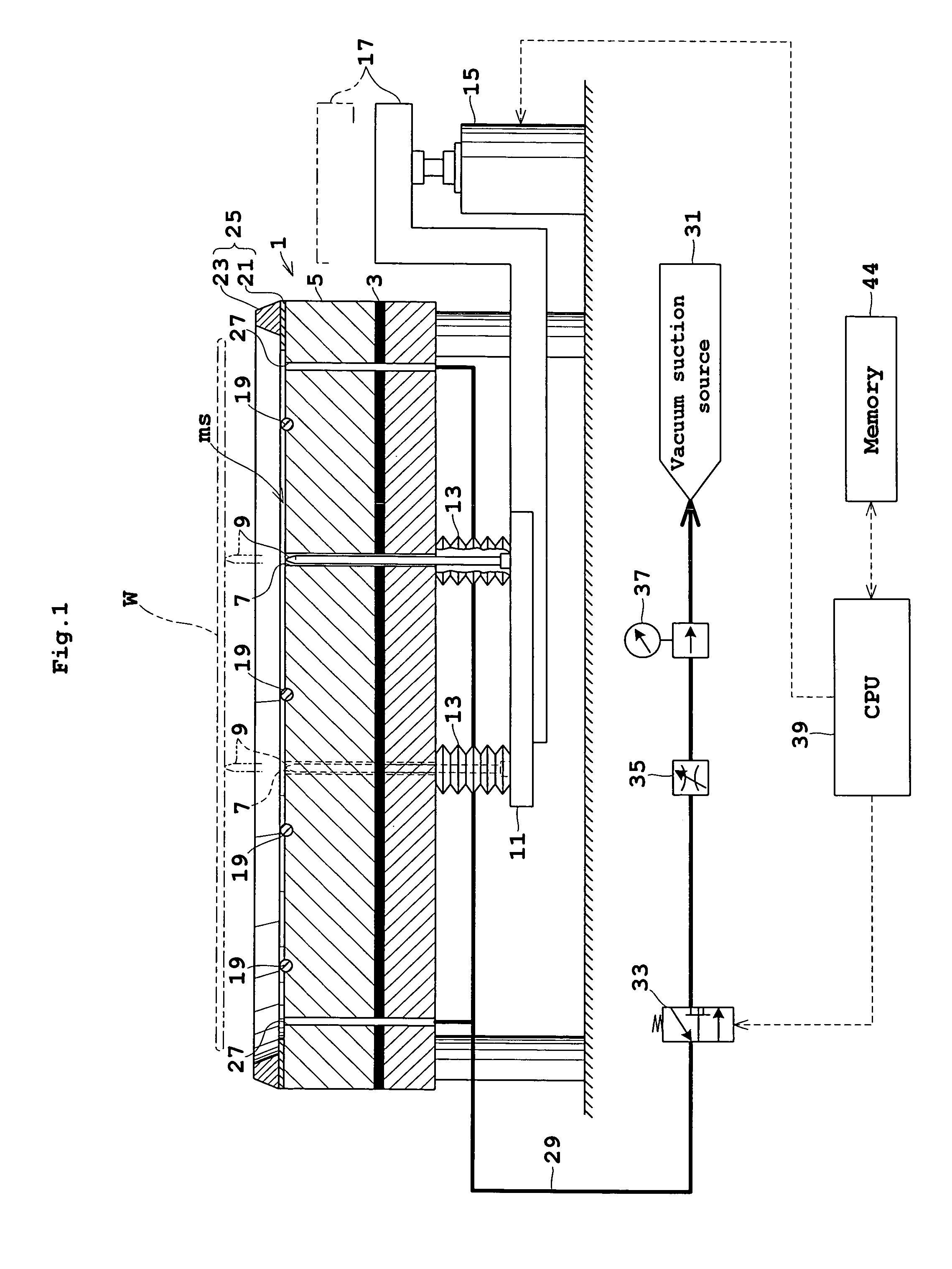Substrate heat treatment apparatus
a heat treatment apparatus and substrate technology, applied in the direction of charge manipulation, furnaces, muffle furnaces, etc., can solve the problems of unevenness, inability to make full use of the highly precise temperature uniformity, and the minute space between the bake plate and the substrate cannot be uniform over the entire surface of the substrate, so as to achieve the effect of increasing the uniformity
- Summary
- Abstract
- Description
- Claims
- Application Information
AI Technical Summary
Benefits of technology
Problems solved by technology
Method used
Image
Examples
embodiment 1
[0042]Embodiment 1 of this invention will be described hereinafter with reference to the drawings.
[0043]FIG. 1 is a view in vertical section showing an outline of a substrate heat treatment apparatus in Embodiment 1. FIG. 2 is a plan view of the apparatus shown in FIG. 1. FIG. 3 is an enlarged view in vertical section of a bake plate.
[0044]A bake plate 1 for supporting a substrate or wafer W on an upper surface thereof has a heating element 3 such as a mica heater mounted in a lower portion thereof. A heat transfer portion 5 between the heating element 3 and the upper surface of bake plate 1 has a plurality of heat pipes, not shown, embedded therein. Cooling grooves, not shown, are formed between the heat pipes for circulating a cooling fluid.
[0045]The bake plate 1 has three perforations 7 extending from the upper surface to the lower surface. These perforations 7 are formed in positions corresponding to the apexes of an equilateral triangle in plan view, each having a support pin 9...
embodiment 2
[0059]Next, Embodiment 2 of this invention will be described with reference FIG. 8. FIG. 8 is a view in vertical section showing an outline of a substrate heat treatment apparatus in Embodiment 2. In the following description, like reference numerals are used to identify like parts which are the same as in Embodiment 1 and will not particularly be described.
[0060]Embodiment 2 relates to an improvement made in the upper surface of bake plate 1A.
[0061]Specifically, the upper surface of bake plate 1A, and more particularly the upper surface of heat transfer portion 5A inwardly of the seal assembly 25, is recessed in a shape of shallow concave around the center. When the wafer W is curved to have the central part bulging downward from the periphery (bowl-like curvature), the central part may be drawn first, with only insufficient suction acting on the periphery. The recessed shape of the upper surface of bake plate 1A allows the periphery of wafer W to be fully drawn. Thus, regardless o...
embodiment 3
[0062]Next, Embodiment 3 of this invention will be described with reference FIG. 9. FIG. 9 is an enlarged view in vertical section of a portion of a substrate heat treatment apparatus in Embodiment 3. Like reference numerals are used to identify like parts which are the same as in Embodiment 1 described hereinbefore, and will not particularly be described.
[0063]Embodiment 3 is different from Embodiments 1 and 2 in the construction of a seal assembly 25A.
[0064]Specifically, the seal assembly 25A includes a support portion 21A and a regulator 23. The support portion 21A has a contact portion 43 and a groove 45. The contact portion 43 has an inside diameter slightly smaller than the outside diameter of wafer W, and an upper surface thereof contactable with a portion of the lower surface of wafer W slightly inward from the edge. The groove 45 is located outwardly of the contact portion 43 and does not contact the lower surface of wafer W.
[0065]When the wafer W is placed in the substrate...
PUM
| Property | Measurement | Unit |
|---|---|---|
| time | aaaaa | aaaaa |
| diameter | aaaaa | aaaaa |
| shape | aaaaa | aaaaa |
Abstract
Description
Claims
Application Information
 Login to View More
Login to View More - R&D
- Intellectual Property
- Life Sciences
- Materials
- Tech Scout
- Unparalleled Data Quality
- Higher Quality Content
- 60% Fewer Hallucinations
Browse by: Latest US Patents, China's latest patents, Technical Efficacy Thesaurus, Application Domain, Technology Topic, Popular Technical Reports.
© 2025 PatSnap. All rights reserved.Legal|Privacy policy|Modern Slavery Act Transparency Statement|Sitemap|About US| Contact US: help@patsnap.com



